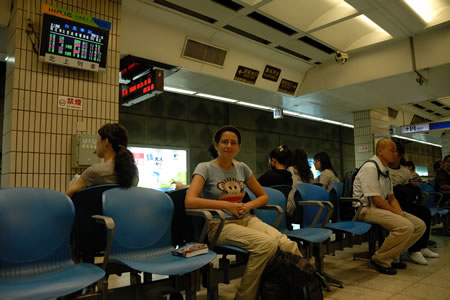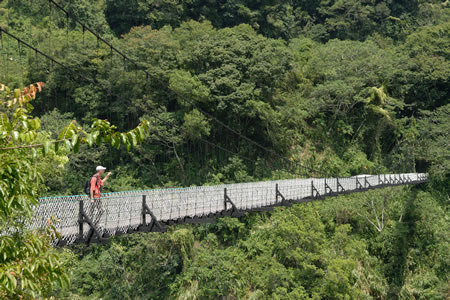English | Dutch |
|
| Sharing the bathroom with a Swami | |
Phu Quoc Island (Vietnam) to Hualien (Taiwan), Aug-27-09 / Sep-18-09 |
|
After our visit of a month to Vietnam, we flew back to the Malaysian capital city Kuala Lumpur. We stayed there for a couple of days before we packed our bags again for our next destination: Taiwan. Taiwan is a destination that isn’t visited a lot by western tourists. There is nobody we know who travelled to this little country, so our expectations were almost blank. But that is understandable. Taiwan doesn’t have world class tourist sites and if you decide as a traveller to bring a visit to Asia, we can image that people tend to choose for countries like Thailand, Cambodia, Malaysia or China. Besides that, the prices in Taiwan are a lot higher than in other countries in the region, making it a relative expensive destination to visit. In a little bit more than four and a half hours, we fly from Kuala Lumpur to Taipei, the capital city of Taiwan. We didn’t had to arrange a visa beforehand, because most western nationalities are eligible for the visa exemption arrangement, which means that you van visit the country up to thirty days without the need of a visa. The immigration and custom formalities are straightforward and within thirty minutes we enter the arrival hall. There are of course several taxi drivers who hope to get a lucrative ride, but we prefer to take the local bus. We are lucky; the transport to the city centre is well organised and after a journey of an hour we are dropped by the bus at the main railway station in the heart of the city. |
|
 |
|
Waiting for the train that will bring us from Taipei to Jaoisi |
|
| We find a small hostel near the railway station, in the centre of the city, also close to the main metro station. We have to get used to the prices in Taiwan, because for a small room with a bunk bed and shared bathroom facilities, we have to pay the whopping amount of € 18. And that is a lot, especially if you compare it with the hotel prices in the countries in the region. Normally, we try to opt for a room with private facilities, because that is a luxury that we allow ourselves. But not in Taipei; so once in a while we have to cross the hallway with a roll of toilet paper under our arm, on our way to the shared bath room. And that the bathroom is indeed shared with others becomes immediately clear. The sink is full of long and grey hairs that belong to our neighbour, is what we find out after several days. The person that occupies the room next to us is an Indian type of guy, with a long grey beard and idem hair. We call him Swami, because of his strong resembling of an Indian Yoga guru. Eventually, we stay five days in Taipei, and for us it is a nice introduction to Taiwan. One of the things that we immediately notice is that the Taiwanese people are extremely friendly, that the atmosphere is relaxed and that the city is well organised. The bus and metro system are extremely effective and efficient, and people queue up neatly to wait for the moment that they can enter the bus or metro. Also in the restaurants people behave very well. Noisiness is rare, people do not eat with sounds and nobody spits on the floor. And that is surprising to us, because we thought that the eating culture would be similar to the Chinese culture. And without being in China before, we heard that this can be a real culture shock. But not here in Taiwan. The country is neat, friendly, organised, not chaotic, and extremely enjoyable. After our visit to Taipei, we took the train to the little town of Jaoisi. Jaoisi is one of the places in Taiwan that is famous for its hot springs. The Japanese and Taiwanese people are known for the fact that they love hot springs. Around the main hot springs in the country, small towns are developed that are completely focused to sell hot spring services to tourists. Most towns have some public hot springs and dozens of hotels that call themselves “hotel & spa”. The hot spring atmosphere is something that we wanted to experience, so for that reason we took the train to Jaoisi. But as soon as we got of the train, we noticed that this is not the spa environment that we had in mind. Jaoisi is a small little town with a lot of high rise hotels that indeed call themselves “hotel & spa”, or even worse “resort & spa”. We expected a more natural environment and didn’t expect spa’s in an urban environment. It seems that all hotels are connected to the hot springs, making the hot spring water in these ugly concrete hotels that lack any atmosphere. But ok, we wanted to experience the hot springs “Taiwanese style”, so we checked out a couple of hotels in the price category that is also uses by most Taiwanese people. All rooms have a spa inside the rooms, which isn’t a lot more than a bath tub. The price of the rooms is related to the size of the bath tub. The higher the price, the bigger the tub, and the more people can enjoy the ‘hot spring’ at the same time. We chose for a mid sized price, so that we could enjoy the spa with the two of us. Most hotels have also a small public hot spring ‘pool’ in the small garden of the hotel, or even on the parking lot, like our hotel had. But these public baths aren’t used a lot by the Taiwanese people, because of the lack of privacy and atmosphere. We checked in for one night, but immediately decided that we will try to find another hot spring elsewhere in Taiwan that answers a little more to our expectations. | |
 |
|
One of the beautiful suspension bridges in Taroko NP |
|
After our visit to Jaoisi, we travel further south along the east coast to the city of Hualien. The city isn’t spectacular, but the main reason to come here is to visit the nearby Taroko National Park. Taroko NP is promoted as one of the major tourist draws of Taiwan. The main highlight is the Taroko Gorge that stretches for more than eighty kilometres over the complete east-west direction of the park. The Liwu River flows through the spectacular marble-walled canyon and travelling over the road that lines the river, is a breathtaking experience. We hiked two days through the park and agree that this place is one of the absolute highlights of any visit to Taiwan. Our next destination on the east coast is the further south located town of Taitung. Also Taitung is a city that is not really worth a visit, unless you want to travel to Green Island. Green Island is a holiday island, located around thirty kilometres off the coast at Taitung, and is extremely popular with local holidaymakers. And already for that reason, we decided to visit the island for a couple of days. The boat ride to the island is only fifty minutes, making it also a popular daytrip. Another important reason to visit the island is the fact that Green Island has one of the only three salt water hot springs that our earth has. And even better, the hot springs are located in a natural and atmospheric environment. At least, that is what the brochures promise. So, after our not-so-good experience last week in Jaoisi, we can’t wait to visit it.
|
|
| <Previous weblog> | |